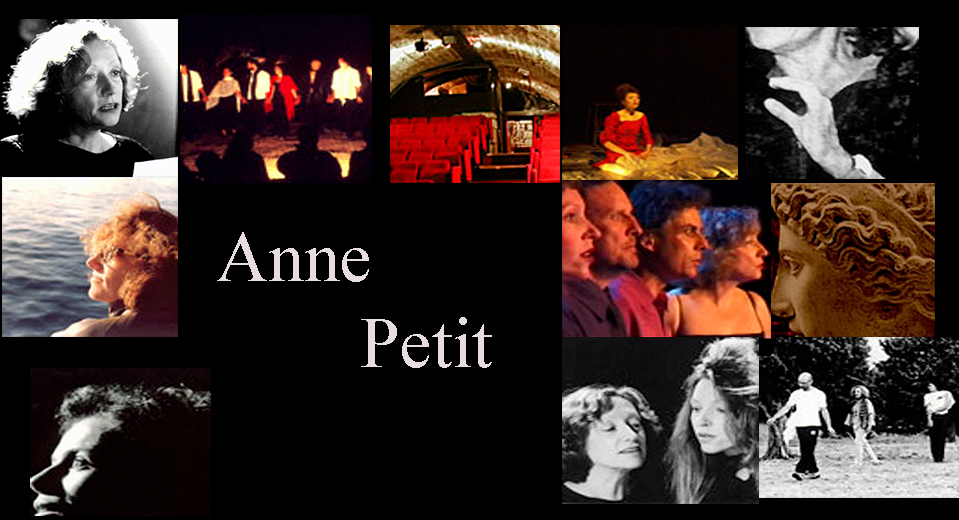
|
|
|
| |
|
|
| |
" Words are empty shells for those who do not share the breath that forged them"
Contes des Sages Taoïstes - L'antre du dragon
|
|
| |
|
|
|
| |
|
|
|
|
|
| |
The development of my theatre workshops involved a work on language, mainly during the AFDAS (Training Insurance Funds) workshops for professional actors, dancers, singers and stage directors, but also during training courses for amateurs and teachers – always followed by a presentation of the work accomplished.
My theatre workshops can be adjusted to the participants' profiles and to the amount of time on our hands. The work can be on contemporary texts as well as on classical plays, with the possibility to focus specifically on reading, improvisation or writing...
In the first AFDAS workshop I conducted (The Captive Voice 1993), I introduced the use of a music stand to convey the specific work on the language I had started two years earlier during the direction Racine's Andromache. I wanted to give the actors a physical constraint and make them work without knowing the script by heart in the first place. As they were processing their work on the language, as their interpretation dawned, as they started to glance at the audience and at their partners, there was such a power of emotion shining that it seemed obvious to me that I had to go further into that type of expression – in workshops as well as in shows.
That is how, a few months later, the first of the Récitals de Textes, dedicated at the cycle By the Tagus... came to life.
|
|
|
 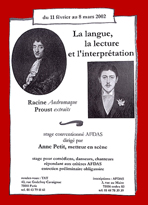

|
|
| |
|
|
|
|
|
| |
|
|
|
|
|
| |
|
|
|
|
|
| |
|
|
|
|
|
| |
The work on language
The word matter: mastering the word, its breath, letting yourself be played by the energy of its breathing, its urge, breathing the text like a music sheet, letting go, becoming an instrument yourself to resonate with its vibrations... A physical task in which the full body is engaged.
How meaning and sound combine to create a text's energy, how its structure determines a breathing, a phrasing, a pulse leading to interpretation. It is also a musical work.
The deep breathing of a text can be determined from its syntactic structure (linked elements, fragmented elements...) and from the movements of the thought (construction of the discourse). So one can find the place for the caesuras, the thin pencil strokes... the light silences which cut the text like they punctuate a music sheet. Of course, the deep breathing of a text matches that of the characters' in their different states, in what they go through. Caesuras are fractures. They are open doors on emotions: feeling, mastering, conveying...
Through Racinian tragedy, through Claudelian verses, through Proustian prose, through contemporary writings, one can perceive how each author has his own breathing beat, his own resounding fabric – just like every actor... - and how crucial it is to not put everything on the same level.
|
|
|

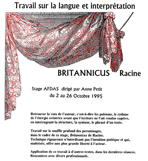
|
|
| |
|
|
|
|
|
| |
|
|
|
|
|
| |
As years went past, I gathered some materials which project this work into a reflexion about the art of acting: to this reflexion, participants have always been sensitive, for this work is based on ethics. The greatest have wondered about the word matter, Copeau speaks of the "significance's music", Jouvet of an "ordered tumult",Stanislavski of "the impulse that gives life to the measuring of language", Laurent Terzieff of "the alchemy between the author's word and the actor's body, between the author's breath and ours", Yoshi Oïda of "the tempo of emotion", Peter Brook of "an infinitely powerful dimension which comes from sound, from the word music". A dimension too often ignored in actors' training.
The need for an inner work, for an intense and fluid concentration, for a better sense of self-listening, to be in a state of availability, of receptivity without tension, all this led me to introduce physical training into my workshops. The exercises – a great number of them were inspired by Yoshi Oïda's experience – all start from a standing position, then actors work on different postures, on grounding, on stretching their spines, on perceiving the tiniest variation of their bodies, the "hara", the flow and concentration of their energy, their breathing, their vocal projection and uttering... This type of work was such a founding one that I always use it, in theatre workshops and rehearsals.
The dynamic introduced by all these elements has also appeared determining in the training of foreign actors, in terms of discourse construction (mastering of the meaning) and in terms of syllabic precision (mastering of the sounding substance of language: words, their flavour, their tension, their resonance...).
In 2018, this work on language was addressed to students of the Department of French, University of Berkeley, California.
|
|
|
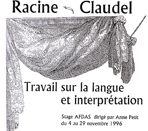
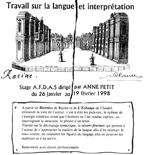
|
|
| |
|
|
|
|
|
|
|
| |
|
|
| |
About students' workshop from the Department of French, University of California, Berkeley, October 2018
A particular literary analysis. Approaching what makes an author' style, from the deep breathing of a text and the word matter
"Literature stages language instead of simply using it" (1)
...first step: After the presentation of the work, reading sessions "at the table" of excerpts from selected texts by analysing their conceptual dimension
- the construction of the discourse, the movements of thought (suspensive part: protase, conclusive part: apodose and acmé, the suspense, light silent between these two sides of the discourse)
- syntax cutting up the text according to the four major operations of syntax.
This syntax cutting allows to determine the respiratory pauses, caesuras-fractures, the thin pencil strokes which cut the text like they punctuate a music sheet...
Introduction of breathing and syllabic exercises useful for any public expression, in any language... or almost...
second step: a phonetic one. Reading at the music stand in the deep breathing of the text... games with caesuras, words, syllables, sharing of some fragments of the selected texts in canon, interventions in one, two or several voices in chorus, in echo- repetitions.
A few comments from the students "It's a real pleasure working with you, and I really appreciated your enthusiasm, and the activities we did on breathing and acmés were very helpful and revealing."
"The breathing exercises did wonders for my anxious mind, while the literary analysis of the suspense/acmé/conclusion in each work we examined expanded my poetic ken. I have gained from your instruction a newfound appreciation of the vocal art of poetry recitation and a renewed - for it has been dormant for some time - confidence presenting before a group in a foreign language. Thank you for your constructive feedback, good humor, grace, and infectious laughter!"
(1)Roland Barthes, in/Leçon au Collège de France
About AFDAS Theatre workshop Racine-Proust 2002
...It was the first time I was working on this author (Proust). I was sure of how interesting it was to approach this unique word matter, but I realised how huge the leap from the fractures in Racinian Alexandrines to the labyrinth, twists and turns of the Proustian prose's characters cast, descriptions, reveries and reflexions... The connection to the characters - evolution, inner pathway - is fundamentally different in Proust's texts, as in all literary texts... After a bit more than two weeks devoted to Racine... we started Proust with a ''caesured'' reading ... The first day was laborious... Difficulties with meaning and syntactical construction. Where then was the main clause? Everyone was looking for it among the meanders of relative, interpolated, parenthetical clauses... On the following day, we used the music stand to work on a short, sharp, concrete, full-of-humour extract: a portrait of the Duke of Guermantes in his private mansion on Faubourg Saint Germain. The text was divided among groups of two, then several actors. Fluency, pleasure gradually showed, then the glances, the silences, the sentences' tempo on which we worked by cutting up the text in various ways
Everyone was able to intervene when they felt like it, cutting up the enumerations, imagining echo-repetitions and coming up with multiple-voice interventions. Playing with caesuras, their breathing - the syllables' sounding matter. Very jazzy indeed... the result exceeded my expectations...
(Extracts from the workshop report)
|
|
| |
|
|
| |
|
|
| |
Training conducted in various workshops
Tchekov and the emotional tumult
Objective: to convey to the audience the inner emotional tumult which troubles, crushes, consumes the characters while they seem to lead an ordinary daily life.
Work on the different dynamics between daily agitation and moments of exception, on the stage comings-and-goings, on the characters' different trajectories, by introducing accidents in their ways using daily objects. For instance a character, at some point, will try to sit down, to get some tea, to go and grab a notebook..., and an accident will prevent that character from doing so: somebody arriving or leaving, a question being asked, an inner doubt, a moment of hesitation, a distraction....
Work on repetitive actions and on the gap between text and action, introduced by those accidents which reveal the inner fractures...
The character and narration in the adaptation of literary texts for the stage
Writing and interpreting. Relation to improvisation. From a short story, building a dramatic structure and constructing characters through determining their life path – who they encountered, who they interacted with... Taking into account the text's literary specificity, the theatrical imperatives that may lead to adjusting the literary dimension, without looking to get rid of it. Avoiding the dilution of the character into the first apparent freedom granted by the absence of concrete dramatic data. Working on the multiple facets of the narration, which is a character's most essential dimension. Narration questions time. Indirect speech, inner voice, action-story, vision-story, transport-story (in which characters live again that moment of the past, when their respective stories ''transported'' them, something Racine held dear), enigma-story (ancient chorus)...
The narration/dialogue, character/narration relations remit to the famous inner/outer relation to which everyone (whether stage director, actor, or set designer...) gets confronted when performing a text, which is also the way to the consciousness of the self, as it appears during the physical training... This relation can be sensed in all great texts. Contemporary authors got that perfectly well. It can also be found in the splintered representation of time, which is most often characteristic of their writing style.
Stage directing
Different modules closely linked: directing actors, coaching; text and dramaturgy; scenic space and dramaturgy, inner/outer relation; designing, building a scenic universe (several examples of stage directions) then staging of a play's fragments by the participants (several versions of a same text).
|
|
| |
|
|
|
|
|
|
 |
|
|
